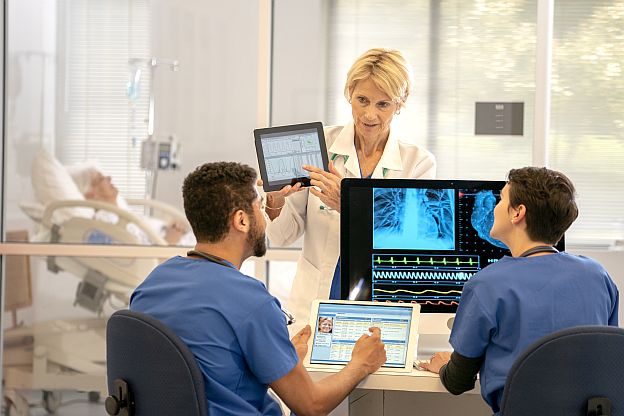Last month I was privileged to speak at HIC2019 in Melbourne about The Clinic Room of the Future. Australian digital healthcare is moving rapidly, driven by the desire for innovation in digital transformation. The 1000+ strong delegates were eager to review solutions that deliver improved patient experience, streamlined operations and protect critical patient data.
Like other countries across the world, healthcare in Australia has reams of clinical documentation. Recent estimates for 2015-16 suggest that there were 10.6 million discharge summaries, 28 million outpatient reports/letters and 2.2 million procedure notes. But is it in a digital format that is useful? The digital health EMR tools only work if their engine room is fueled with quality data. Speech recognition is a key ingredient and ‘magic bullet’ to overcome the data entry burden that the EMR can place upon clinicians and help transform healthcare services.
The underestimated impact of clinical documentation
Research found that clinicians spend about 11 hours per week creating their documentation. Add to that, time spent looking for lost notes, duplicating them and other admin tasks. Estimates of up to 50 per cent of clinician time can be spent on documentation. This results in only around 13 per cent of their working time spent with patients. With our ability to speak up to three times faster than typing, speech recognition software is a key method of releasing more clinician time away from these administrative tasks. However, the health system will only benefit from this if the information going into the Electronic Patient Record, or the ‘Electronic Health Engine’, is accurate and of good clinical quality. The best way of ensuring this is to make the recording of this information a seamless and natural by-product of clinician-patient engagement.
Clinical speech recognition delivers measurable outcomes
There are a number of examples from the UK where speech recognition software has helped this process:
- In the outpatient department, clinicians using it has led to turnaround times for GPs and patients receiving letters dropping from weeks to just two to five days at the Homerton University Hospital NHS Trust.
- Outsourced transcription costs have fallen and the need for additional secretarial support to cope with backlogs has significantly reduced. This has also been replicated at Oxford Universities Hospitals NHS Foundation Trust.
- We have found similar outcomes in the community physiotherapy service, mental health service and histopathology service. In the latter, a backlog of 600 pathology cases was removed and the organisation is now exceeding the national turnaround target.
Secure cloud-service including artificial intelligence in speech recognition and beyond
After its huge success in the US and UK, Nuance now introduces Dragon Medical One for Australia´s clinicians. Dragon Medical One is an AI embedded, cloud-based clinical speech recognition solution for documenting care in clinical applications, foremost the EMR. Delegates at HIC2019 had the opportunity to try it for themselves and create their own note using speech. Its speed and accuracy spoke for itself. Plus, the option for the clinician to use their smartphones as a wireless microphone for dictation was thought to be a real bonus.
Hosted in Microsoft’s Azure cloud, clinicians can simply open the DMO application, choose the section where they want to document and start speaking. The electronic patient record will be updated directly. Due to the AI embedded neural networks, there is no need for any initial training of the speech engine. The smart algorithms provide the clinician with improved accuracy and speed with their documentation, whether it be an admission note, ward round note, procedure note, discharge summary or the outpatient letter. It allows the clinician to focus more on face-to-face patient care rather than typing.
Mobile and fast clinician experience
- Clinicians can access Dragon Medical speech recognition from anywhere. Whether they are in an outpatient clinic, on the ward, or even at another hospital.
- Providing that a secure network is in place, Dragon Medical One allows to be using speech ‘on the go’.
- The speech recognition provided by Dragon Medical One can be used on any device, fixed or mobile.
- The Dragon Medical One cloud-service allows a fast, lightweight deployment with low system administration and hardware costs.
- Updates and access to new features are immediate with the application being flexible across the organisation to meet any change in clinical workflow or service models.
- The Dragon Medical one cloud-based speech recognition service is always available and secure.
As HIC2019 drew to a close, it was clear that the need for real time, quality clinical information requires an industrial strength tool such as speech recognition to support the clinicians with their documentation process. Combined with other considerations such as interoperability, the national health record, myHealth portal, privacy & delivering value-based healthcare, cloud-based AI-embedded speech recognition can assist healthcare providers achieve their goals for digital innovation within the fast-changing Australian medical landscape.







